Squat Sets And Reps: Everything You Need To Know
Author:
Reviewed by:
(21 years of Oly Lifting experience)
Unlock your full potential by engaging with our experts and community! Have questions about your fitness journey or looking for expert advice on weightlifting techniques? Don’t hesitate — leave a comment below and Jason Li will provide a personalized answer and insights to help you reach your goals.
Torokhtiy is reader-supported. Some links are affiliate links, and we may earn a commission at no extra cost to you. See our disclosure page for details.
Squats are recognized as one of the best leg-strengthening exercises available. They’re simple and you can gradually increase the reps and/or the weight you’re holding to increase your gains.
We’re here to help you understand the importance of squat sets and reps volume and help create your squat training plan.
Does The Volume Of Squat Sets And Reps Make A Difference? Yes. The more squats sets and reps you do the more you’ll build muscle size. However, volume isn’t the only way to strengthen your muscles or achieve hypertrophy. It’s also important to consider the weight you’re squatting.
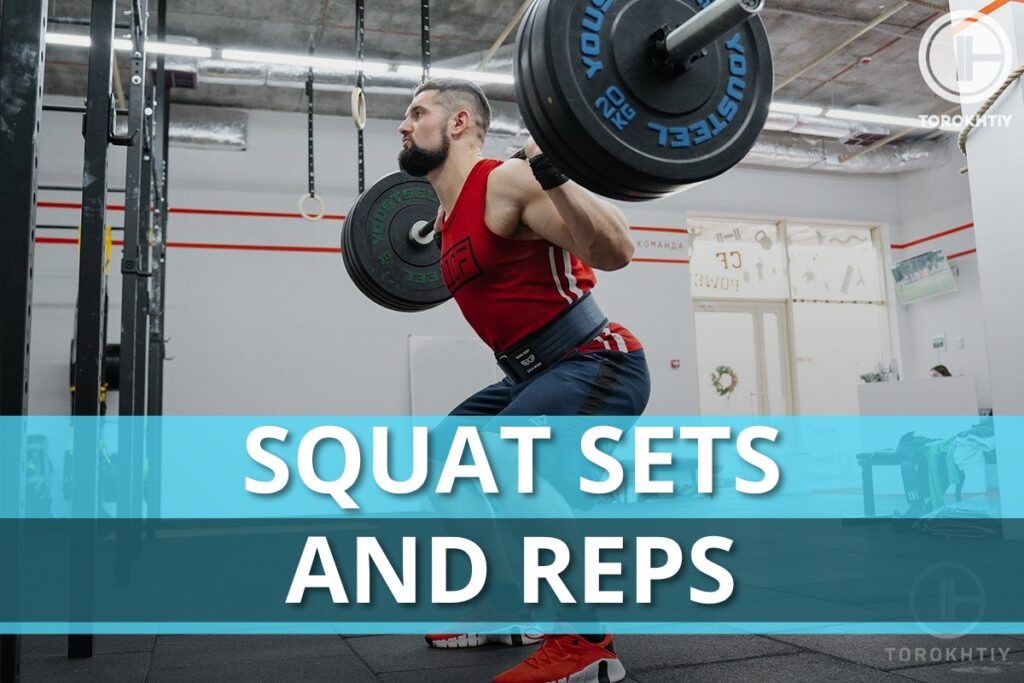
The Importance Of Squat Volume
You’re going to come across a wide variety of suggestions regarding optimizing your squat training plan. However, before you can define your squat reps and sets you need to understand the importance of squat volume. It will help you create the perfect training plan.
It should be noted that squat depth is also an important consideration. Research has shown deeper squats are better at developing specific lower body muscles, such as your glutes and inner thigh muscles.
In a nutshell, volume is the most important element of muscle growth and endurance. Studies show that muscle strength can increase with high and low volumes but hypertrophy is directly linked to higher training volumes.
This is worth knowing as you create your training plan. You should also consider the following:
1. Time Available
If you have limited time then your plan should center around lifting heavy with low volume. This will help you achieve the best possible gains with the time you have available.
2. Your Goals
Squats are excellent at improving lower body strength. However, you can’t just work on your lower body, you’ll want to balance muscle growth across your body. When creating a training plan you need to consider your whole body and whether you’re looking to gain strength or muscle size.
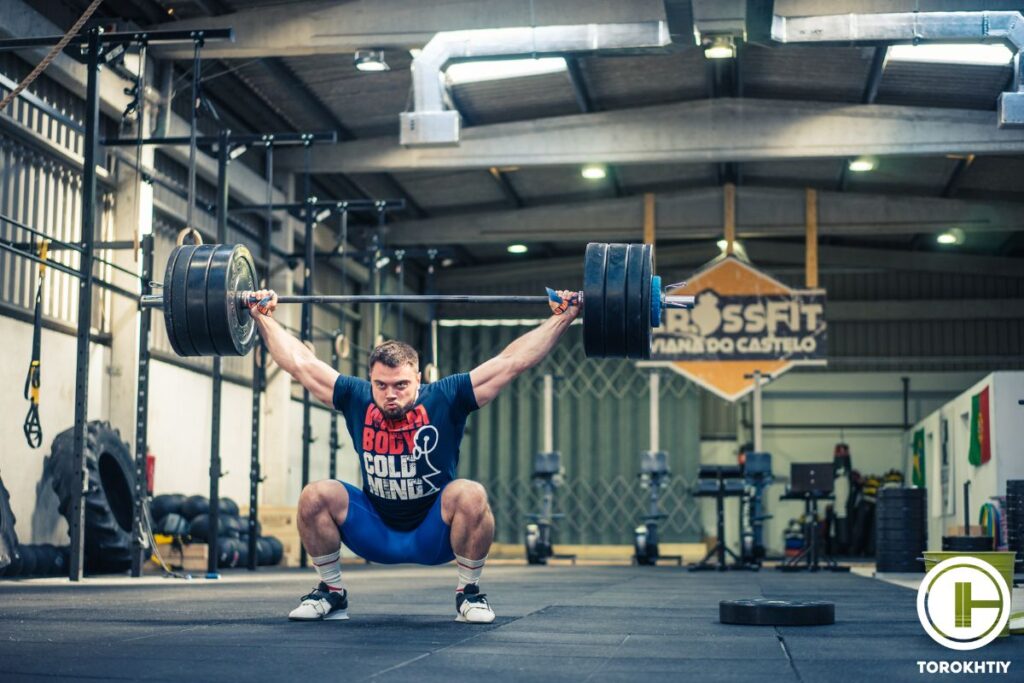
3. Training Days
This ties in with the time you have available and your goals. You’ll be able to define how many days you should be training and how many you can fit in.
In a moment we’ll go into some suggested training plans for you.
Why Your Approach Matters?
When deciding your preferred squat sets and reps or how many sets of squats you should do, you must be clear about what your aim is.
It’s possible to get stronger without growing huge muscles. Equally, it’s possible to get huge muscles without gaining excessive amounts of stress.
Are you interested in getting stronger or looking more buff? Knowing the answer to this will help you answer how many reps of squats you should do.
Follow us!

Free!
Get a 2-week Weightlifting Program as a bonus for the subscription to kickstart your training plan!

Free!
1. For Strength Growth
This approach favors lifting as heavy as you can while squatting. Your aim will be to do 4-6 reps and just 2-3 sets.
This approach allows you to lift your maximum weight, pushing your muscles as hard as possible, effectively maximizing your gains.
You should aim to be exhausted as you finish your sets. Because you’re pushing your limits with every squat, you’ll also need longer breaks between sets. Of course, the whole process will mean less time working out than with a high volume, low-weight routine.
Spotters are always a good idea but they are particularly important if this is your preferred approach as you’re pushing exhaustion with each set.
Of course, you can also see impressive strength gains if you gradually increase the number of reps you do with heavy weights. You will need to take it slow and you will be fatigued at the end, but this approach can boost strength and endurance, with impressive gains over several months.
2. For Hypertrophy
If you are looking to build your endurance then high volume with low weights is a good approach. You’ll need to choose a weight that you can lift 12-16 times for 3-6 sets. The rep range for squats is significantly bigger when doing high volume workouts, which is why it won’t be your one-lift max!
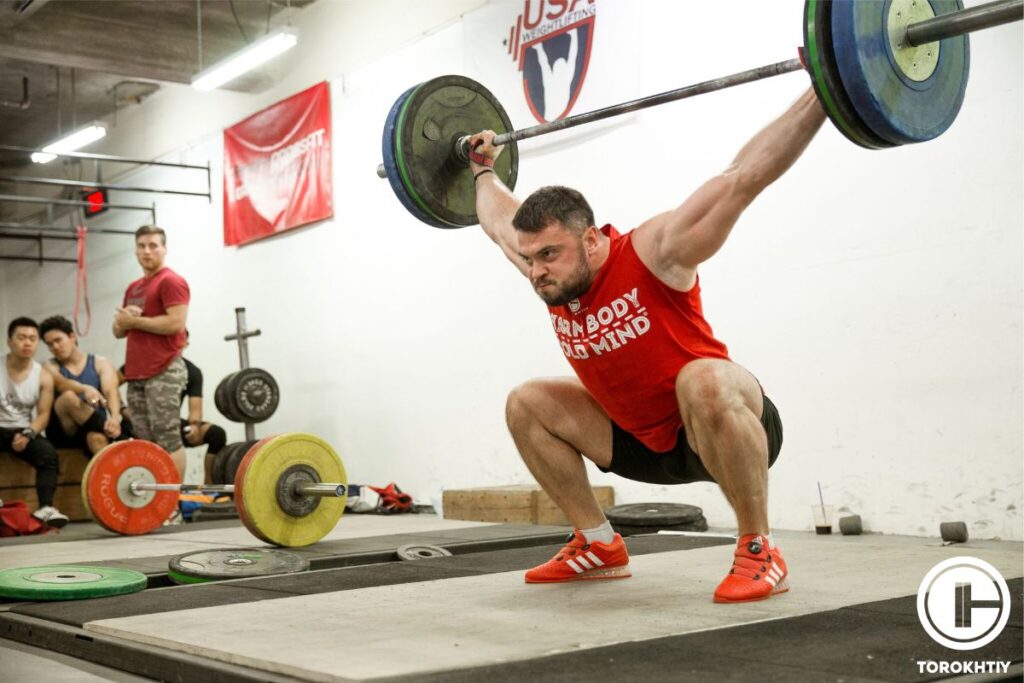
It’s important to quantify that low weight doesn’t mean going easy on yourself. This should still be hard work and you will need to pick a weight that allows you to complete the squat reps and sets without exhaustion but still challenges you.
At the end of a high volume, low-weight squat routine you’ll feel pumped but not over-exerted. Research shows this is the approach favored by lifters looking to increase muscle size.
Understanding why you’re approaching a workout in a specific way will help motivate you and ensure you’re looking for the right results.
After all, if you’re looking to grow the size of your muscles and are focusing on high-intensity, low-volume squats, you’re unlikely to get the results you want.
How Many Sets And Reps Of Squats Should You Do?
Having worked out what your aims are you’ll be asking how many reps of squats should you do and how many sets of squats should you do. To decide this, consider the following:
1. Current Fitness Level
People doing squats for the first time may need to start squatting without weights. This will help to ensure you have good form before you start loading up. In general, if you’re new to squatting you can aim to do between 12-15 reps and 3 sets.
However, what you can actually do will be dictated by your fitness level. If you can’t manage that squat rep range, do less and work up to it.
🔻GET A FREE PROGRAM DEMO: 12 Week Squat Program by Oleksiy Torokhtiy
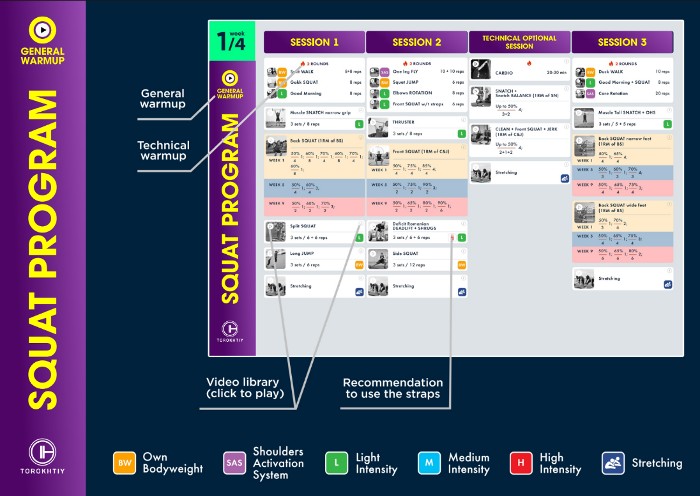
Do you want to double your squat strength? In just 12 weeks, you’ll be able to boost your squat results.
Enter your details and get a free demo (1 free week) of the squat program straight into your inbox.
2. Intention
We’ve spoken about goals, specifically whether you’re looking to improve muscle strength or size. However, some people are doing squats as part of a goal to lose fat. In this instance 3 sets of 10-12 reps, ensuring you can just complete the reps, is likely to produce good results.
3. Your Overall Workout Plan
The higher the intensity of your squats, the longer you’ll need to leave between sessions. This may give you the time you need to target other muscles.
However, being consistent means muscle memories are created. In short, your body will get better at performing squats. This adaptation is lost surprisingly quickly. A recent study of 12 older women found that despite a 22-week training program, their muscles deadapted in just one month.
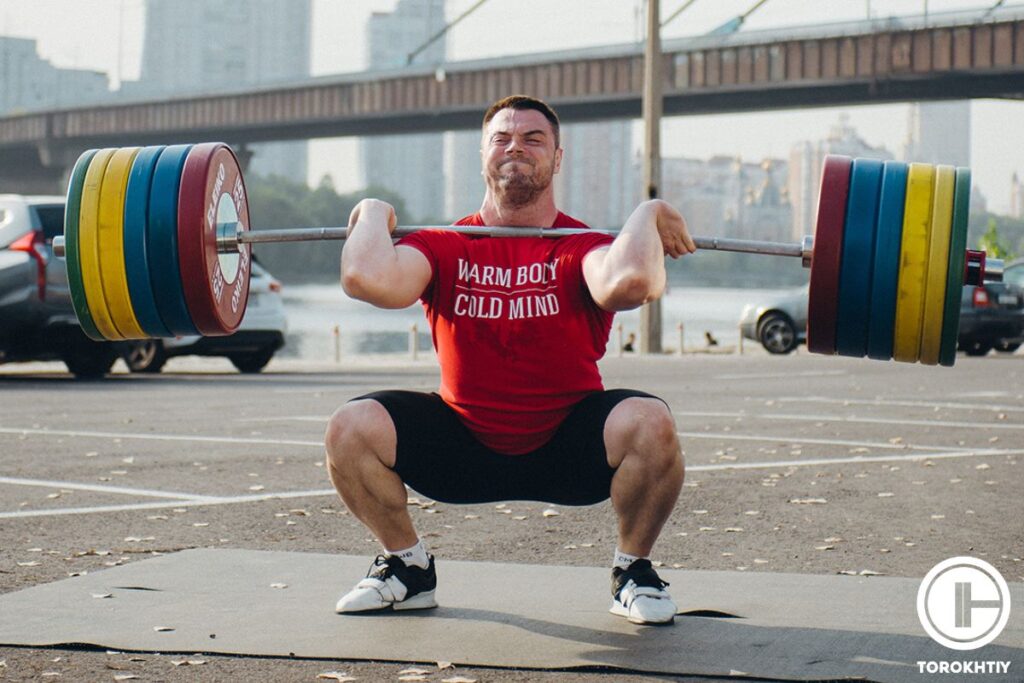
In short, when creating a plan don’t leave too long a gap between workouts. A month may seem like a long time but if you opt for high-intensity and low-volume squats, you may leave 10 days between sessions. You only have to miss two squat sessions to start losing your gains!
For that reason, higher volumes and lower weights, with a target of 3-6 sets of 12 reps could be your best option.
Training Squat Plan Depending On Your Goals
Now you know what you want from your squats you’ll be able to decide the right volume and even the depth of the squat you’re aiming for.
Here are some possible plans:
1. For Muscle Hypertrophy
If your goal is to get large muscles then you’ll need a muscle hypertrophy plan, such as this:
| Day 1 | Day 2 | Day 3 | Day 4 |
|---|---|---|---|
| Back squat 4 sets of 8 reps | Box jumps 4 sets of 6 reps | Front squats 4 sets of 8 reps | Kettlebell swings 4 sets of 8 reps |
| Bulgarian split squats 3 sets 10 reps | Plyometric lunges 3 sets of 8 reps per leg | Hack squats 3 sets of 8 reps | Jump squats 4 sets of 6 reps |
| Romanian deadlifts 3 sets of 8 reps | Speed squats 4 sets of 5 reps | Good mornings 3 sets of 10 reps | Olympic barbell thrusters 3 sets of 8 reps |
| Leg press 3 sets of 10 reps | Depth jumps 3 sets of 6 reps | Walking lunges 3 sets of 12 reps per leg | Box jumps 3 sets of 8 reps |
On day five, have a rest day before repeating.
2. For Strength Development
To build strength you’ll want to do the following:
| Day 1 | Day 2 | Day 3 |
|---|---|---|
| Bench back squat 3 sets of 4 reps | Leg press 3 sets of 4 reps | Front squat 3 sets of 4 reps |
| Paused back squat 3 sets of 4 reps | Stiff-leg deadlifts 2 sets of 6 reps | Three position squats 2 sets of 4 reps |
| Narrow stance squat 2 sets of 5 reps | Leg extensions 2 sets of 6 reps | Goblet squats 3 sets of 6 reps |
| Wide stance squat 3 sets of 6 reps | Leg curls 2 sets of 6 reps | Split squats 3 sets of 4 reps |
Take a rest day before repeating.
3. For Endurance
An endurance plan will look like this:
| Day 1 | Day 2 | Day 3 | Day 4 |
|---|---|---|---|
| 10 minutes of dynamic stretches targeting the lower body | 10-minute warm up with high jumps and tuck jumps | 10-minute warm up focusing on dynamic mobility | Warm up for 10 minutes with full-body stretches |
| Back squats 5 sets of 5 reps | Jump squats 4 sets of 6 reps | Front squat 5 sets of 5 reps | Squat pyramids 10 reps, followed by 8 reps, 6 reps, then 4 reps, increasing weight as you lower reps |
| Pause squats 3 sets of 4 reps | Box squats 4 sets of 6 reps | Sumo deadlifts 3 sets of 8 reps | Bulgarian split squats 3 sets of 8 reps |
| Walking lunges 3 sets of 12 reps | Goblet squats 3 sets of 10 reps | Calf raises 4 sets of 15 reps | Leg curls 3 sets of 10 reps |
On day 5 have a rest before starting again.
FAQ
How Many Squats Should I Do?
The answer to this depends on your current fitness level and your goal. Doing more squats with lower weights, such as 12-16 reps and 3-6 sets, is good for hypertrophy.
In contrast, 2-3 sets of 3-6 reps at maximum weight is better for strength.
Should I Do 8 or 15 Reps of Squats?
Eight reps allow you to lift heavier and will help build strength. Trying to do 15 reps will mean a lower weight. That’s generally considered better for building hypertrophy.
Should I Go Heavy on Squats?
This depends on your aim. Going heavy focuses on muscle strength over size. However, you need to know your limits before lifting heavy. The aim is to only just be able to lift the last rep of the last set.
It’s often best to mix high-volume and low-volume training.
Do I Need to Squat Till Failure?
If you’re aiming to build strength then yes. Squatting to failure means you’ve pushed your muscles to their limits. You’ll have created microtears in them which leads to stronger muscles as they heal.
It’s a good idea to push yourself to failure sometimes.
Conclusion
Choosing the right number of squat sets and reps is a personal decision. It’s defined by your goals and your current fitness level.
Our training plans will help you get started and we’re here to answer any questions. All you have to do is get started, and there is no better time to do that than now!
Also Read:
- Bench Back Squat
- Wall Squat
- What Muscles Do Squats Work? (Lifting Coach Explains)
- Squatting With Long Femurs: Tips For Lifters With Long Legs
- Squat and Deadlift Same Day: Right or Wrong?
- Shoulder Pain When Squatting: Causes & Prevention
- Safety Bar Squats: Form & Benefits Explained
- Lower Back Pain When Squatting: Causes & Fixes
- How Much Should I Be Able To Squat? Squat Standards Explained
- Do Squats Make Your Butt Bigger? (Improve The Result)
- Squat Stance: Understanding The Foundations
Referenses:
- Kubo K, Ikebukuro T, Yata H. Effects of squat training with different depths on lower limb muscle volumes. Eur J Appl Physiol. 2019 Sep;119(9):1933-1942. doi: 10.1007/s00421-019-04181-y. Epub 2019 Jun 22. PMID: 31230110.
- SCHOENFELD, B. J., CONTRERAS, B., KRIEGER, J., GRGIC, J., DELCASTILLO, K., BELLIARD, R., & ALTO, A. (2018). Resistance Training Volume Enhances Muscle Hypertrophy but Not Strength in Trained Men. Medicine and Science in Sports and Exercise, 51(1), 94-103. https://doi.org/10.1249/MSS.0000000000001764
- Krzysztofik, M., Wilk, M., Wojdała, G., & Gołaś, A. (2019). Maximizing Muscle Hypertrophy: A Systematic Review of Advanced Resistance Training Techniques and Methods. International Journal of Environmental Research and Public Health, 16(24). https://doi.org/10.3390/ijerph16244897
- Krzysztofik, M., Wilk, M., Wojdała, G., & Gołaś, A. (2019). Maximizing Muscle Hypertrophy: A Systematic Review of Advanced Resistance Training Techniques and Methods. International Journal of Environmental Research and Public Health, 16(24). https://doi.org/10.3390/ijerph16244897
- Rodrigues, B., Gonçalves, O., & Uchida, M. C. (2017). Effects of a short-term detraining period on muscle functionality and cognition of strength-trained older women: A preliminary report. Journal of Exercise Rehabilitation, 13(5), 559-567. https://doi.org/10.12965/jer.1735010.505
Why Trust Us?
With over 20 years in Olympic weightlifting, strength training, nutrition coaching, and general fitness our team does its best to provide the audience with ultimate support and meet the needs and requirements of advanced athletes and professional lifters, as well as people who strive to open new opportunities and develop their physical capabilities with us.
By trusting the recommendations of our certified experts in coaching, nutrition, and sports training programming, as well as scientific consultants, and physiotherapists, we provide you with thorough, well-considered, and scientifically proven content. All the information given in the articles concerning workout programming, separate exercises, and athletic performance, in general, is based on verified data.
The product testing process is described in more detail here.
Author: Jason Li
Personal Coach, Functional Range Conditioning Mobility Specialist
Jason is an NYC personal training expert and National level Olympic Weightlifting Coach with over 10 years of experience training everyday clients to high levels of performance. He has trained everyone from youth (13 years old and under) to masters (60+ years old) to regional and national rankings for powerlifting, Olympic Weightlifting, Short distance (up to 200m) sprinting, discus & hammer throwing.
Reviewed by: Oleksiy Torokhtiy
Olympic Weightlifting Champion, PhD in Sport Science
Best Results: Snatch – 200 kg,
C&J – 240 kg
Oleksiy Torokhtiy is a professional athlete boasting 20 years of experience in Olympic weightlifting. With multiple European and World titles under his belt, he has showcased his prowess in two Olympic Games (Beijing 2008 and London 2012). Upon concluding his illustrious career, Oleksiy dedicated himself to coaching. By 2022, he had conducted over 200 weightlifting seminars worldwide. He is the visionary behind an international sportswear and accessories brand known for its motto, “Warm Body Cold Mind.” Additionally, he is an esteemed author and the creator of a series of training programs and eBooks.




Still have questions after reading our article? Unlock your full potential by engaging with our experts and community! Don’t hesitate — leave a comment below and Jason Li will provide a personalized answer and insights to help you reach your goals.